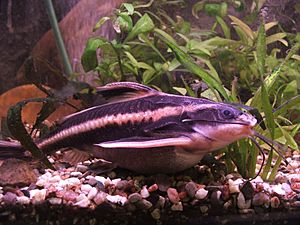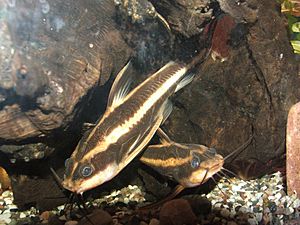Striped Raphael catfish facts for kids
Quick facts for kids Striped Raphael catfish |
|
|---|---|
 |
|
| Scientific classification | |
| Synonyms | |
|
The striped Raphael catfish (Platydoras armatulus) is a cool fish from the Doradidae family. People also call it the Southern striped Raphael, talking catfish, chocolate doradid, chocolate catfish, or thorny catfish. This fish lives in the Amazon, Paraná, and lower Orinoco river areas in South America. It's a calm fish that is active mostly at night. Many people like to keep it in aquariums because it's friendly and interesting. Even though it's called a "talking catfish," it doesn't actually speak words!
This catfish used to be confused with another fish, Platydoras costatus, which lives in Suriname and French Guiana. The main difference is that the pale stripe on P. costatus doesn't go onto its head.
Contents
About the Striped Raphael Catfish
Where They Live and What They Eat
These fish like to dig into the soft bottoms of rivers. You can often find them in sandy areas. They eat small creatures like snails and crabs. They also eat tiny pieces of plants and other things that float in the water.
Special Features and Size
The striped Raphael catfish has strong spines on its fins. It also has many small, curved spines along its body. These spines help protect it from other animals. Most of these fish grow to be about 20 to 24 centimeters (8 to 9.5 inches) long. Some very large ones have been found, reaching up to 43 centimeters (17 inches)!
Young Fish as Cleaners
When they are young, striped Raphael catfish sometimes act like "cleaner fish." This means they clean other, bigger fish. For example, they have been seen cleaning fish like Hoplias cf. malabaricus. The stripes on the young catfish might be a signal that tells other fish they are cleaners. As they get older, their stripes are not as bright. This is why only the young fish usually do the cleaning.
Striped Raphael Catfish in Aquariums
Good Tank Mates
The striped Raphael catfish is a great fish for a community aquarium. They are peaceful with other catfish and different kinds of fish. But remember, they are active at night. This means you might not see them much during the day. They often hide and rest.
How to Handle Them Safely
It's best not to use a fish net to catch a striped Raphael catfish. When they get scared, they can stick out their fin spines very stiffly. These spines can get tangled in a net. It's hard and even dangerous for both you and the fish to untangle them. It's better to use other ways to move them, like a container.
Breeding and Sounds
It is hard to tell the difference between male and female striped Raphael catfish. Also, no one has successfully bred them in captivity yet. This means that the fish you see in pet stores are usually caught from the wild.
These catfish can make interesting grunting or squeaking noises. They often do this when they are out of the water. Even though they are usually friendly, sometimes they might try to eat very small fish. So, be careful when adding one to a tank with tiny fish.
See also
 In Spanish: Platydoras armatulus para niños
In Spanish: Platydoras armatulus para niños
- List of freshwater aquarium fish species


